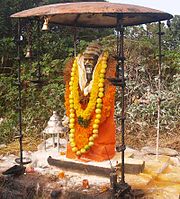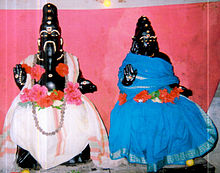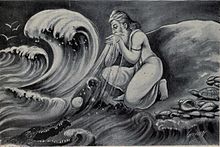 Agastya is one of the saptarishis who are extolled at many places in the Vedas and a revered Vedic sage and earliest Siddhar. He is also believed to be the author of Agastya Samhita. The word is also written as Agasti and Agathiyar. A-ga means a mountain, and Asti means thrower. Agastya the Muni, son of Urvashi was born of both Gods, Mitra and Varuna. Agastya is also the Indian astronomical name of the star of Canopus, is said to be the 'cleanser of waters', since its rising coincides with the calming of the waters of the Indian Ocean. He was son of Pulasthya, son of Brahma.
Agastya is one of the saptarishis who are extolled at many places in the Vedas and a revered Vedic sage and earliest Siddhar. He is also believed to be the author of Agastya Samhita. The word is also written as Agasti and Agathiyar. A-ga means a mountain, and Asti means thrower. Agastya the Muni, son of Urvashi was born of both Gods, Mitra and Varuna. Agastya is also the Indian astronomical name of the star of Canopus, is said to be the 'cleanser of waters', since its rising coincides with the calming of the waters of the Indian Ocean. He was son of Pulasthya, son of Brahma.
Siddhar were spiritual adepts who possessed the ashta siddhis, or the eight supernatural powers. Sage Agathiyar is considered the guru of all Siddhars, and the Siddha medicine system is believed to have been handed over to him by Lord Muruga, son of the Hindu God Lord Shiva and Goddess Parvathi.Siddhars are the followers of Lord Shiva. Agathiyar is the first Siddhar. His disciples and other siddhars contributed thousands of texts on Siddhar litratures, including medicine and form the propounders of the system in this world.He is considered as the Father of Tamil literature and compiled the first Tamil grammar called Agathiyam. It is believed that he has lived in the 6th or 7th century B.C and specialized in language, alchemy, medicine and spirituality (yogam and gnanam). There are 96 books in the name of Agathiyar. However, some Tamil researchers say that Agastya mentioned in Vedas and Agathiyar mentioned in Tamil texts could be two different characters. In Tamil language the term 'Agam' means inside and 'iyar' means belong. One who belong inside (soul) is the Tamil meaning for Agathiyar.
Agastya and Lopamudra
 Agastya needed to marry and sire a son, in order to fulfill his duties to the Manus. Once he resolved upon doing this, Agastya pursued an unusual course of action: by his yogic powers, he created a female infant who possessed all the special qualities of character and personality that would be appropriate in the wife of a renunciate. At this time, the noble and virtuous king of Vidarbha (an area in south-central India, just south of the Vindhya mountains), was childless and was undertaking penances and offering prayers to the divinities for the gift of a child. Having come to know the plight of the king, Agastya arranged for the transformation of the child he had created, to be born the daughter of that noble king of Vidarbha. The child thus born was named "Lopamudra" by her parents. Upon her attaining marriageable age, Agastya approached the king and sought the hand of his daughter. The king was initially chagrined to hear such a suggestion from a renunciate, but found that his daughter, who had already exhibited extraordinary standards of mind and character, was insistent that he should accept the proposal. She was utterly intent upon renouncing the royal palace of her father and set out to live in forest at the hermitage of Agastya. Lopamudra and Agastya were duly married and lived a life of extraordinary felicity and happiness. It is believed that they had two sons - Bhringi & Achutha. In Mahabharata (Vana Parva: Tirtha-yatra Parva), there is mention of his penance at Gangadwara (Haridwar),in Uttar Khand State in India, with the help of his wife, Lopamudra (the princess of Vidharba).Lopamudra attained the rank of one of Mahapativrathas in the world by her dedication to worship her husband Agastya, and remained with other Pathivrathas (Noble exalted wives),like Mandodari (Ravana's wife),etc.
Agastya needed to marry and sire a son, in order to fulfill his duties to the Manus. Once he resolved upon doing this, Agastya pursued an unusual course of action: by his yogic powers, he created a female infant who possessed all the special qualities of character and personality that would be appropriate in the wife of a renunciate. At this time, the noble and virtuous king of Vidarbha (an area in south-central India, just south of the Vindhya mountains), was childless and was undertaking penances and offering prayers to the divinities for the gift of a child. Having come to know the plight of the king, Agastya arranged for the transformation of the child he had created, to be born the daughter of that noble king of Vidarbha. The child thus born was named "Lopamudra" by her parents. Upon her attaining marriageable age, Agastya approached the king and sought the hand of his daughter. The king was initially chagrined to hear such a suggestion from a renunciate, but found that his daughter, who had already exhibited extraordinary standards of mind and character, was insistent that he should accept the proposal. She was utterly intent upon renouncing the royal palace of her father and set out to live in forest at the hermitage of Agastya. Lopamudra and Agastya were duly married and lived a life of extraordinary felicity and happiness. It is believed that they had two sons - Bhringi & Achutha. In Mahabharata (Vana Parva: Tirtha-yatra Parva), there is mention of his penance at Gangadwara (Haridwar),in Uttar Khand State in India, with the help of his wife, Lopamudra (the princess of Vidharba).Lopamudra attained the rank of one of Mahapativrathas in the world by her dedication to worship her husband Agastya, and remained with other Pathivrathas (Noble exalted wives),like Mandodari (Ravana's wife),etc.
Legends and beliefs about Agastya
Sage Agastya is often considered the father of traditional Indian Medicine among many other streams of knowledge. In his book, he is believed to have given the description of, and instructions for the creation of medicines for many types of fevers, cancer, treatments for impotence, abdominal problems, brain and eye problems, bone problems, etc.
Among the various legends associated with him is that of the Vindhya Mountains. According to a story in the Shri Rama-Charitra-Manasa, at one time, Mount Vindhyachal was continually growing in size due to taunting comments by the Sage Narada. So as to temper the vanity of the mountains, Sage Agastya and his family traveled to South India, via the Mount Vindhyachal. On their way, when the Vindhyas saw Sage Agastya, he bowed with respect and reverence, upon which Sage Agastya, jokingly asked if he would stay bowed and subdued with respect till the sage returned. The Vindhyas was truly benevolent and promised to not grow until the seer's return from the South. After passing through the mountain, sage Agastya told his wife, that they would never again cross over to the North side of mount Vindhyas.
Another reference is in the Mahabharata Book 10 in Sauptikaparva, section-12 as the sage who gave Drona, the greatest of weapons, Brahmastra (used by both Arjuna and Ashwatthama at the end of the war).
Agastya's Hermitage and references in Valmiki's Ramayana
Agastya is mentioned most among all the existing Hindu texts possibly in the Ramayana. He is mentioned in the oldest and most original existing versions of the Ramayana (those by Sage Valmiki), as having his abode in the form of a hermitage in the Malaya Mountains, at more than one place. His main hermitage is placed by the epic somewhere in the western half of the Indian Ocean, further south of the so-called Malaya Mountains, amongst a series or chain of large islands and submerged mountains. His hermitage building there is supposedly eighty miles in both length and breadth, and again an astounding eighty miles in height as well, and adorned with inestimable amounts of gold, diamonds, and all other kinds of precious metals and stones.
Vathapi legend
Another story has it that two demon brothers, Ilvala and Vathapi, used to kill Brahmins as a revenge in a special manner.Ilvala had once requested a Brahmin to bless him for getting a son as powerful as Indra, the king of gods. The Brahmin refused the request right away. That made the demon angry. He wanted to take revenge on all Brahmins because one of them refused to grant him his wish.
He had a younger brother by name Vatapi. Being demons, the two had special powers. They came up with a plan to take revenge on Brahmins. Ilvala would turn his brother into a goat. He would invite any passer-by, especially Brahmins, for a grand feast at his house. He would cut his brother, turned goat, into pieces and cook a delicacy with it. He would offer the guest this special meat dish.
After meal he would call his brother out, "Vatapi”. His brother would respond from the belly of the visitor and come out alive in one piece. In the process the guest would be killed. The two demons, later, would enjoy a curry made of human flesh. All the valuables in the possession of the visitor would go into their treasure.
Ilvala was so good at cooking that the smell of the food started attracting Brahmins around.They queued to have a taste of it.Anyone who went inside the eating place never came back and the brothers were intelligent enough to only allow one Brahmin to enter and eat at a time.Thus the numbers of Brahmins began to reduce.One day,Agastya happened to pass through.By the plan,as usual, one changed into a goat and the other disguised himself as a Brahmachari who invited Agastya to a meal. Agastya knew beforehand about the plan due to his immense Vedic powers, but he resolved to teach both a lesson. After the meal, Agastya simply rubbed his stomach saying Vathapi JeerNo bhava; literally may Vathapi be digested, while the other demon tried to bring his brother to life in vain. Agastya plainly informed the demon that his brother has been digested and could no longer be brought back to life.
Other facets of Agastya
 Very ancient period before Agastya, on the period of "Abhisheka pandian", On the grace of lord Shiva (avatar) "Sundharanandhar" is a first siddhar in world. Those incident (Thiruvilaiyadal) was held in Madurai. He is avatar of Lord Shiva explain to the people about meaning of "Siddhas" and also he explained human body is control by "Pancha boodham". Agastya is considered as the first and foremost Siddha. He is considered the guru of many other Siddhas. He is also called Kurumuni, meaning short (kuru) saint (muni). He made contributions to the field of Medicine and Astrology - especially Nadi astrology. He is said to have lived for over 5000 years, and that one of his medicinal preparations, Boopathi Kuligai, is so powerful that it can even bring the dead back to life. Two of his students and disciples were Therayar and Tholkappiar.
Very ancient period before Agastya, on the period of "Abhisheka pandian", On the grace of lord Shiva (avatar) "Sundharanandhar" is a first siddhar in world. Those incident (Thiruvilaiyadal) was held in Madurai. He is avatar of Lord Shiva explain to the people about meaning of "Siddhas" and also he explained human body is control by "Pancha boodham". Agastya is considered as the first and foremost Siddha. He is considered the guru of many other Siddhas. He is also called Kurumuni, meaning short (kuru) saint (muni). He made contributions to the field of Medicine and Astrology - especially Nadi astrology. He is said to have lived for over 5000 years, and that one of his medicinal preparations, Boopathi Kuligai, is so powerful that it can even bring the dead back to life. Two of his students and disciples were Therayar and Tholkappiar.
Another story about him is that once when the great sage accompanied by his beloved royal wife were wandering through forests, she fainted due to the humidity and hot conditions prevailing in the south. She was royal, hence not exposed to hard conditions. By seeing this the great sage became angry and prepared to punish the Sun God. The sun god immediately, frightened, appeared before Agastya and presented him with umbrella and chappals (foot wear).
Certain important Stotrams
- The Lalita sahasranama, which describes the 1000 names of the Goddess Lalita (known commonly as Dākshāyani, Pārvatī or Durgā), was first revealed to the world when Hayagrīva, a manifestation of Viṣṇu, taught the same to Agastya.
- Agastya is progenitor of the Aditya Hṛdayam, a hymn to Sūrya taught to Rāma just before Rāma's battle against Rāvaṇa.
- Agastya also composed Saraswati Stotram.
Agastyar - Tamil Movie


